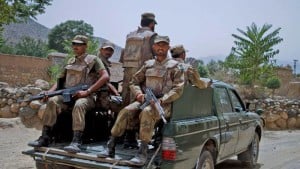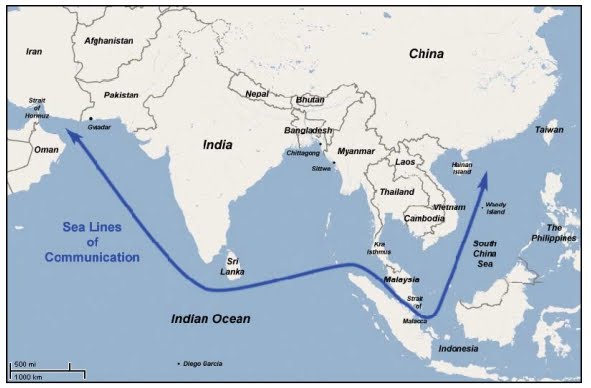ISIS “Coincidentally” Appears Along China’s One Belt, One Road

Two Chinese teachers based in Pakistan’s southwest province of Baluchistan were reportedly abducted and murdered by militants from the self-proclaimed “Islamic State” (ISIS).
CNN, in an article titled, “‘Grave concern’ over Chinese teachers reportedly killed by ISIS in Pakistan,” would attempt to portray the act of terrorism as a random strike aimed at China’s expanding economic activity abroad.
In reality, the terror attack was very precise in terms of location and purpose, and fits into a larger pattern of violence and political instability that has plagued Pakistan’s Baluchistan province and China’s ambitions there for years.
US Using Proxies to Disrupt China-Pakistan Economic Corridor
Baluchistan, and more specifically, the port city of Gwadar, serve as the central nexus of the China-Pakistan Economic Corridor (CPEC). It is a complex and expanding system of rail, roads, ports, and other infrastructure projects built jointly with the Pakistani government to facilitate regional economic growth – and an integral component of the much larger One Belt, One Road initiative.

Disrupting China’s economic lifelines to the rest of the world is an open objective of US policymakers. A paper published in 2006 by the Strategic Studies Institute titled, “String of Pearls: Meeting the Challenge of China’s Rising Power across the Asian Littoral.” identified Gwadar by name as one of several components of China’s “String of Pearls.”
The report states explicitly in regards to a possible “hard approach” toward Beijing that:
There are no guarantees that China will respond favorably to any U.S. strategy, and prudence may suggest to “prepare for the worst” and that it is “better to be safe than sorry.” Is it perhaps better to take a hard line towards China and contain it while it is still relatively weak? Is now the time to keep China down before she can make a bid for regional hegemony? Foreign policy realists, citing history and political theory, argue that inevitably China will challenge American primacy and that it is a question of “when” and not “if” the U.S.-China relationship will become adversarial or worse.
What better way to contain China’s regional ambitions than to mire economic development in places like Baluchistan with armed militancy, or obstruct it altogether with a US-backed independence movement in the province?
US policymakers have noted just that. In a 2012 paper published by the Carnegie Endowment for International Peace titled, “Pakistan: The Resurgence of Baluch Nationalism” (PDF), it would be stated unequivocally that (emphasis added):
If Baluchistan were to become independent, would Pakistan be able to withstand another dismemberment—thirty-four years have passed since the secession of Bangladesh—and what effect would that have on regional stability? Pakistan would lose a major part of its natural resources and would become more dependent on the Middle East for its energy supplies. Although Baluchistan’s resources are currently underexploited and benefit only the non-Baluch provinces, especially Punjab, these resources could undoubtedly contribute to the development of an independent Baluchistan.
Baluchistan’s independence would also dash Islamabad’s hopes for the Gwadar port and other related projects. Any chance that Pakistan would become more attractive to the rest of the world would be lost.
Not only would it be Pakistan’s loss regarding the Gwadar port, it would be China’s loss as well.
And while the paper attempts to claim the US stands nothing to gain from Baluchistan’s independence, the US State Department has spent years and an untold sum of money and resources supporting just such an independence movement. Additionally, the Carnegie Endowment for International Peace itself hosted an event by the “Baloch Society of North America,” advocating US intervention in the province toward achieving “independence.”

The US State Department’s National Endowment for Democracy (NED) and Open Society via “Global Voices” funds a long list of organizations in Pakistan’s Baluchistan province advocating everything from autonomy to outright independence. This includes the Association for Integrated Development Balochistan (AID Balochistan), The Balochistan Point, and the Balochistan Institute for Development.
The US NED-funded Institute for Development Studies & Practices’s (IDSP) president regularly uses social media like Twitter to make and support statements calling for Baluchistan’s independence and depicting the province as a “colony” of Pakistan. So do virtually all other members of the above mentioned organizations funded by the US government.
The long list of US-funded Baluchistan-based organizations regularly link to op-eds and propaganda depicting violence in the province as one-sided and perpetuated by Pakistani forces alone – echoing the same sort of intentionally skewed public relations campaigns supporters of US-backed violence in Syria have undertaken since 2011.
And just like in Syria, the violence being spun, excused, or glossed over directly meshes with US interests – in this case – impeding Chinese-Pakistani cooperation in Baluchistan and beyond.
Violence in Baluchistan Benefits US Proxy War with Iran Also
That the Islamic State has claimed responsibility for this latest attack, following in the wake of a larger attack on Tehran, Iran, is particularly significant. It was US policymakers who, in a 2009 Brookings Institution policy paper titled, “Which Path to Persia? Options for a New American Strategy toward Iran,” would mention Baluchistan and Baluchi separatists by name as possible conduits, safe havens, and proxies for conducting armed conflict against Iran.
Creating violence in Baluchistan, Pakistan thus serves to not only mire Chinese ambitions across Asia, it assists Washington’s long-standing objective to encircle Iran with hostile state and non-state actors ahead of eventual regime change operations against Tehran.
Previously, the United States has attempted to use a variety of local groups to foment political instability and violence. Now it appears that all of its geopolitical mischief is being lumped under the catch-all, the “Islamic State.” In reality, the militants who kidnapped and murdered the two Chinese teachers in Baluchistan, Pakistan, were likely local militants the US has been backing for years, and whose role in destabilizing Pakistan is increasingly understood by local and global audiences.
Assigning blame to the Islamic State appears to be a means of disassociating America from the violence it is intentionally fueling across the region.
The Islamic State “coincidentally” appearing in virtually every geopolitical theater on Earth US interests are impeded or challenged by local and regional interests helps explain why not only the Islamic State exists in the first place, but explains how it has managed to survive and continue to thrive despite multinational efforts by nations like Russia, Syria, and Iran to defeat it.
Through state sponsorship, the Islamic State’s source of logistical, political, and military power ultimately lies in Washington, London, Brussels, Ankara, Riyadh, and Doha – where Russian-Syrian-Iranian military and political power cannot reach.
For those wondering where the Islamic State will strike next, one needs only to look at a world map and identify where else US interests are being impeded by an increasingly multipolar world unwilling to yield to Wall Street and Washington’s corporate-financier monopolies. As illustrated in this recent and abhorrent attack in Baluchistan, Pakistan, important points along China’s One Belt, One Road project would be important places to look out for.
By targeting teachers, such terrorism seeks to incite fear across the very workers who are part of implementing this ambitious regional economic plan. It is a motive that resides far above the crude ideological motivations generally assigned to the Islamic State, and instead resembles well thought-out – if not sinister – geostrategic planning.
Tony Cartalucci, Bangkok-based geopolitical researcher and writer, especially for the online magazine “New Eastern Outlook”.
All images in this article are from the author.

